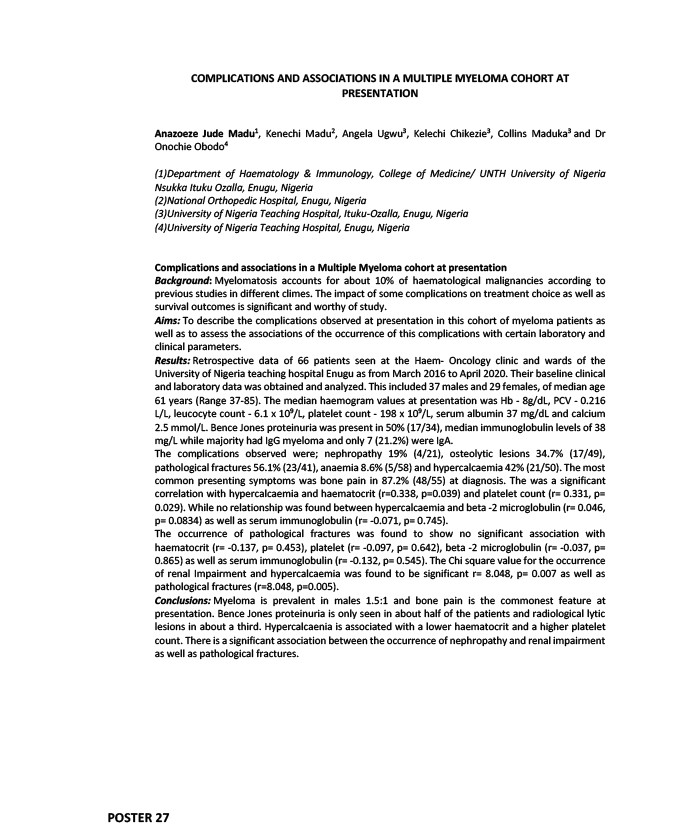
POSTER 27
COMPLICATIONS AND ASSOCIATIONS IN A MULTIPLE MYELOMA COHORT AT
PRESENTATION
Anazoeze Jude Madu1, Kenechi Madu2, Angela Ugwu3, Kelechi Chikezie3, Collins Maduka3 and Dr
Onochie Obodo4
(1)Department of Haematology & Immunology, College of Medicine/ UNTH University of Nigeria
Nsukka Ituku Ozalla, Enugu, Nigeria
(2)National Orthopedic Hospital, Enugu, Nigeria
(3)University of Nigeria Teaching Hospital, Ituku-Ozalla, Enugu, Nigeria
(4)University of Nigeria Teaching Hospital, Enugu, Nigeria
Complications and associations in a Multiple Myeloma cohort at presentation
Background: Myelomatosis accounts for about 10% of haematological malignancies according to
previous studies in different climes. The impact of some complications on treatment choice as well as
survival outcomes is significant and worthy of study.
Aims: To describe the complications observed at presentation in this cohort of myeloma patients as
well as to assess the associations of the occurrence of this complications with certain laboratory and
clinical parameters.
Results: Retrospective data of 66 patients seen at the Haem- Oncology clinic and wards of the
University of Nigeria teaching hospital Enugu as from March 2016 to April 2020. Their baseline clinical
and laboratory data was obtained and analyzed. This included 37 males and 29 females, of median age
61 years (Range 37-85). The median haemogram values at presentation was Hb - 8g/dL, PCV - 0.216
L/L, leucocyte count - 6.1 x 109/L, platelet count - 198 x 109/L, serum albumin 37 mg/dL and calcium
2.5 mmol/L. Bence Jones proteinuria was present in 50% (17/34), median immunoglobulin levels of 38
mg/L while majority had IgG myeloma and only 7 (21.2%) were IgA.
The complications observed were; nephropathy 19% (4/21), osteolytic lesions 34.7% (17/49),
pathological fractures 56.1% (23/41), anaemia 8.6% (5/58) and hypercalcaemia 42% (21/50). The most
common presenting symptoms was bone pain in 87.2% (48/55) at diagnosis. The was a significant
correlation with hypercalcaemia and haematocrit (r=0.338, p=0.039) and platelet count (r= 0.331, p=
0.029). While no relationship was found between hypercalcaemia and beta -2 microglobulin (r= 0.046,
p= 0.0834) as well as serum immunoglobulin (r= -0.071, p= 0.745).
The occurrence of pathological fractures was found to show no significant association with
haematocrit (r= -0.137, p= 0.453), platelet (r= -0.097, p= 0.642), beta -2 microglobulin (r= -0.037, p=
0.865) as well as serum immunoglobulin (r= -0.132, p= 0.545). The Chi square value for the occurrence
of renal Impairment and hypercalcaemia was found to be significant r= 8.048, p= 0.007 as well as
pathological fractures (r=8.048, p=0.005).
Conclusions: Myeloma is prevalent in males 1.5:1 and bone pain is the commonest feature at
presentation. Bence Jones proteinuria is only seen in about half of the patients and radiological lytic
lesions in about a third. Hypercalcaenia is associated with a lower haematocrit and a higher platelet
count. There is a significant association between the occurrence of nephropathy and renal impairment
as well as pathological fractures.